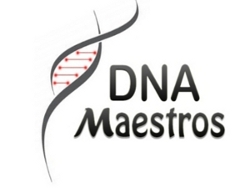Biomod/2012/IITG/DNA Maestros:Introduction

Home Introduction The Project Materials & Methods Results and Discussion Conclusion Team Members Acknowledgements
Structural DNA nanotechnology has fostered the viable construction of materials at the nanoscale[1]. The ability of double stranded DNA to behave as rigid rods below the persistence length and single stranded DNA to act as molecular glue due to highly specific base pairing properties renders DNA an ideal material for nanoscale construction. A rationale-based engineering of the sequences of nucleotides on DNA strands can lead to the construction of a broad spectrum of architectures like one-dimensional (1D) tube, wires, two-dimensional (2D) sheets, tiles as well as three dimensional polyhedra and crystals[2]. Construction of various dynamic devices like nanomachines, robots and walkers have been realized in past by using DNA[3]. One of the emerging sub-fields of DNA nanotechnology is the construction of regular three-dimensional (3D) polyhedra based on platonic solids. A variety of such polyhedra have been constructed using different methods like one pot synthesis, modular assembly and origami based approaches[4, 5, 6] . Most polyhedra created till date have been postulated to have applications as “smart” drug delivery vehicles[7, 8]. A few reports in this regard have demonstrated the encapsulation of various cargo within DNA polyhedra and their preliminary applications in cells and in vivo[9, 10]. However, in order to fully exploit the potential of these polyhedra, the major challenges that need to be addressed are 1) to develop methods to precisely target cargo-loaded DNA polyhedra to specific sites in vivo 2) to realize strategies that can enable the spatiotemporal release of the cargo. Thus, to enable the use of such DNA based polyhedra for targeted drug delivery, the cargo release process should be coupled to the sensing of bio-molecular cues such as ions, small molecules, metabolites, nucleic acids or proteins. With highly complex diseases like cancer, a single bio-marker is not sufficient for a positive diagnosis. In such cases, the drug-delivery vehicles should be able to sense a number of signals and then subsequently release distinct payloads.
Recently, certain DNA based nanostructures have been developed to display specific molecular payloads upon sensing specific molecular cues. Douglas et al. demonstrated the use of a DNA origami barrel, which functions like a clamshell that is programmed to sense a cellular cue and display sequestered antibodies to specific cell surface proteins[11]. DNA-based three dimensional (3D) polyhedra could use such a lock-and-key mechanism to function as drug delivery agents for a variety of molecular cargo. However, in order for them to be genuinely considered as delivery vehicles in living systems, DNA based capsules and containers must possess minimal amount of DNA and also the potential to site-specifically modify them with ligands without perturbing their structure. Additionally, the DNA scaffold should be tunable to sense more than one target, by introducing minimal changes to the proposed design.
Importantly, single stranded nucleic acids also have the ability to bind chemicals ranging from small molecules to macromolecules, specifically. Such single strands of DNA or RNA are referred to as aptamers or functional nucleic acids[12]. Our idea was to combine the structural power of a DNA icosahedron to encapsulate various cargoes, and integrate them with the chemical power of a recognition event mediated by aptamers and an external bio-cue such that a binding event would result in the disruption of the DNA capsule to release its internal cargo. Our work describes a generalized strategy broadly applicable to a variety of target responsive nucleic acid sequences integrated into any DNA polyhedron in order to bring about controlled opening of polyhedra and release of encapsulated molecules.
References
-
Seeman, N.C. Nanomaterials Based on DNA. Ann. Rev. Biochem. 79, 65-87 (2010).
-
Bhatia, D., Sharma, S. & Krishnan, Y. Synthetic, biofunctional nucleic acid-based molecular devices. Curr. Opin. Biotech. 22, 475-484 (2011).
-
Krishnan, Y. & Simmel, F. C. Nucleic acid based molecular devices. Angew. Chem. Int. Ed. 50, 3124-3156 (2011).
-
Goodman, R. P., Schaap, I. A. T., Tardin, C. F., Erban, C. M., Berry, C. M., Schmidt, C. F. & Turberfield, A. J. Rapid chiral assembly of rigid DNA building blocks for molecular nanofabrication. Science 310, 1661-1665 (2005)
-
Bhatia, D., Mehtab, S., Krishnan, R., Indi, S. S., Basu, A. & Krishnan, Y. Icosahedral DNA nanocapsules by modular assembly. Angew. Chem. Int. Ed. 48, 4134-4137 (2009).
-
Douglas, S. M., Dietz, H., Liedl, T., Hogberg, B., Graf, F. & Shih, W. M. Self-assembly of DNA into nanoscale three-dimensional shapes. Nature 459, 414–418 (2009).
-
Zhang, C., He, Y., Su, M., Ko, S. H., Ye, T., Leng, Y., Sun, X., Ribbe, A. E., Jiangh, W. & Mao, C. Faraday Discuss. 143, 221-233 (2009).
-
Aldaye, F. A., Palmer, A. L. & Sleiman, H. F. Assembling materials with DNA as the guide. Science 321, 1795-1799 (2008).
-
Bhatia, D., Surana, S., Chakraborty, S., Koushika, S.P. & Krishnan, Y.* A synthetic, icosahedral DNA-based host-cargo complex for functional in vivo imaging. Nat Commun. 2: 339 doi:10.1038/ncomms1337 (2011).
-
Lee, H., Lytton-Jean, A.K.R., Chen, Y., et al. Molecularly self-assembled nucleic acid nanoparticles for targeted in vivo siRNA delivery. Nat. Nanotech. 7, 389-393 (2012) .
-
Douglas, S. M., Bachelet, I., & Church, G. M. A logic-gated nanorobot for targeted transport of molecular payloads. Science 335, 831-834 (2012).
-
Carothers, J.M., Goler, J.A., Kapoor, Y., et al. Selecting RNA aptamers for synthetic biology: investigating magnesium dependence and predicting binding affinity. Nucleic Acids Res. 38, 2736-2747 (2010).

